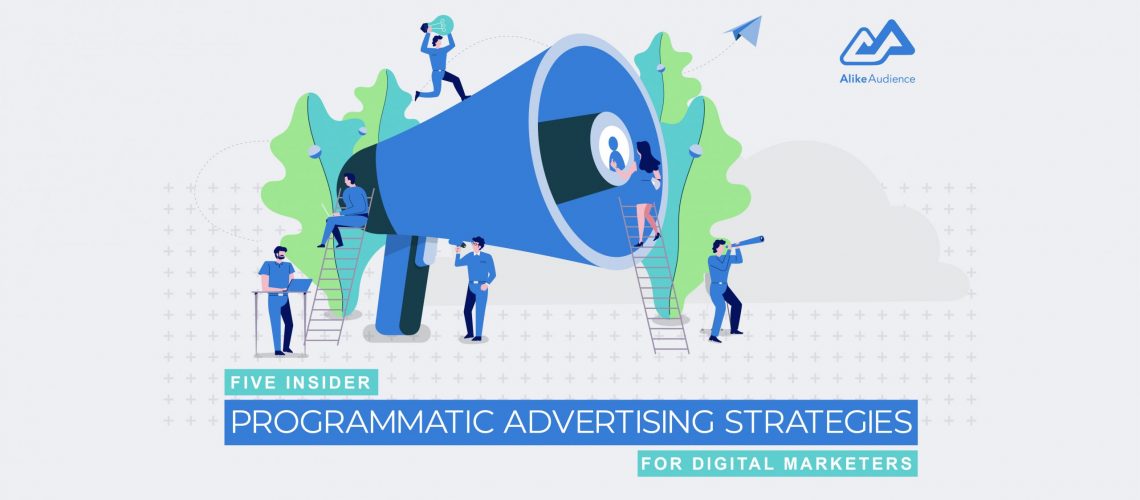Programmatic advertising is essentially every ad that touches the Internet – whether it’s at the bottom of a webpage that is native, or the audio ads on subscription-based music streaming services like Spotify or Pandora.
Prior to the first-ever Internet banner ad in 1993, it remained difficult for advertisers to access traditional advertising inventory – meaning that nearly 40-60 percent of publisher inventory often went unsold.
Fast forward to today, advertisers across the US were projected to spend around US$106 billion on programmatic digital advertising in 2021, with expenditures set to rise to US$142 billion by 2023.
In this article, we explain what programmatic advertising platforms are and take you through five actionable strategies for devising effective programmatic campaigns.
Table of Contents
What are programmatic advertising platforms?
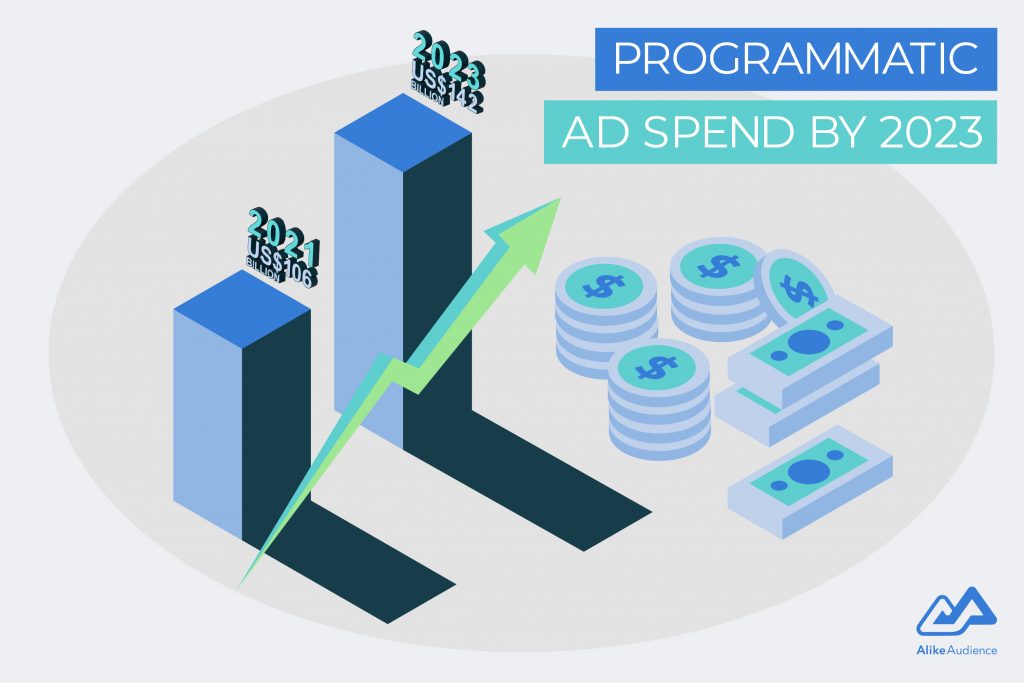
Programmatic advertising platforms pair artificial intelligence (AI) with real-time bidding (RTB) for media buying in real-time. A programmatic ad buying platform takes raw data about your customers, segments it, understands it, and sells the data to you for audience targeting. It’s open and interoperable with lots of other tools, such as Facebook, YouTube, and more.
The programmatic buying landscape contains three main components:
- Supply-side platform (SSP): takes care of the supply and distribution of ad inventories.
- Demand-side platform (DSP): software that allows you to buy ad inventories on any platforms.
- Ad exchanger: a digital marketplace where you can buy and sell advertising space through real-time bidding auctions
The evolution of programmatic advertising
Decades ago, back when media buying was in its rudimentary stages, marketers adopted a “guess-and-measure” approach, where they advertise on a medium with the largest pool of audiences and made a prediction on how many viewers saw their ads.
But this is shortsighted: there’s no way of knowing how many of those audiences are actually interested in your product, much less how many of them picked up the phone to place orders. Most of the time, ad spend went to waste without any concrete results. Even if you got a lucky break, there was no way to attribute the results back to a particular ad.
This is where programmatic ad buying came in. Through data insights and algorithms on real-time auction, marketers can now strategically deliver the right messages to the right audiences on the right channel and analyze insights in real-time.
In this article, we talk to top media buyers and traders and draw on our expertise as a data provider in the US and APAC ad-tech industry to help you plan out your programmatic campaign.
We’ll cover five main strategies:
- Understanding your customers.
- Choosing your data vendor.
- Mapping an omnichannel strategy and setting goals.
- Adjusting your programmatic marketing plan.
- Using data science for measurement.
Strategy #1: Understanding your customers through audience segmentation is the holy-grail.
Connecting with your customers is now more important than ever for marketers. 82% of customers regularly purchase from brands that they have a high emotional engagement with, so much so that retailers can see a 5% boost in annual revenues simply by driving emotional engagement with customers.
One of the biggest mistakes you can make when planning your programmatic advertising campaign is to touch your customers last at the end of the funnel and trick them into “seeing” your ads (think of ads popping up every few seconds on a webpage), without actually creating any sort of value exchange.
Rather than focusing on common metrics like return on investment (ROI) and click-through rates (CTR), implementing a customer-first approach on your programmatic ad campaign can lead to better returns on investment.
But trying to connect with all 2.14 billion customers in the world is going to be unheavenly expensive and just virtually impossible. How do you fish out the most profitable ones from this massive ocean?
Building lookalike models through audience segmentation
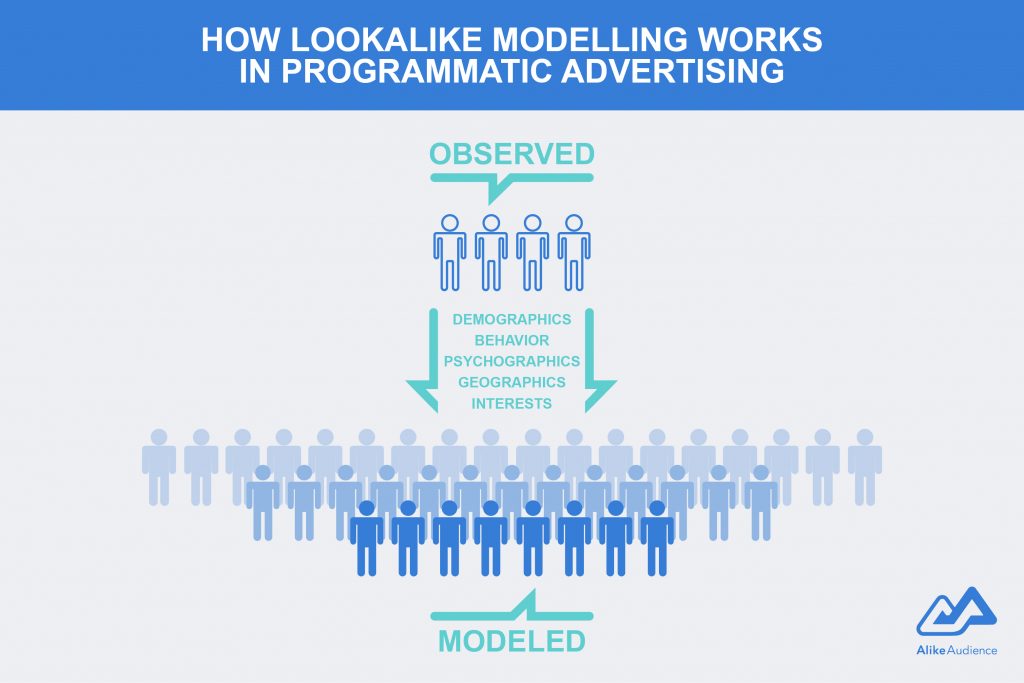
The good news is that you can use first, second, and third-party data to better understand your customers. Then, plug this custom audience data in your programmatic campaign.
Through custom segments built for a specific market or objective, you can learn more about the common demographic, psychographic, and behavioral characteristics of your current customers. Use this data to target new customers who share similar characteristics in your ad campaigns. This process is called lookalike modeling.
Lookalike models are the most fundamental layer to the success of your programmatic ad campaign. When you know who your prospective customers are, you can direct marketing efforts to deliberately connect with them. Everything you plan for the campaign–from creating ads to deciding advertising channels–must match the interests of lookalike audiences.
At AlikeAudience, we build lookalike models through audience segmentation: using big data collected from mobile devices, desktops, and transaction data to divide audiences based on gender, age, location, interests, behavior, and other characteristics.
Our proprietary machine learning (natural language processing and geospatial analysis) models data from trusted sources to result in high campaign performances.
Audience segmentation helps marketers tailor their offers, products, and services to the best prospects for better engagement and successful conversion. While market segmentation is used by marketers to group their audiences, audience segmentation involves target audiences which can be activated in your programmatic ad campaigns via digital ad tech tools and media platforms.
Discover five audience segmentation strategies to get the most out of programmatic advertising.
Defining your lookback window
One tool that is prevalently used in audience segmentation is a lookback window. After your ad is clicked or viewed, lookback windows indicate the period of time within which a desired action, such as a purchase, can be matched to that particular ad.
Lookback windows differ according to the market or industry. Products that don’t require a long decision making process garner a shorter lookback window than those which do.
When you work with data vendors to build your custom audience segments, let them know how long or short you need your lookback windows to be. Generally, the longer the lookback window, the more insights there are, and the higher the conversion data will be.
AlikeAudience offers a variety of audience segments with lookback windows ranging from 365 to 90 days. For instance, our demographic segments embody a longer lookback window of 365 days while our seasonal segments have a 90-day window. We can also create custom segments with any window you require.
Data vendors play a critical role in building custom segments that define your look alike models. In the next section, we give you advice on how to choose the right data provider that can help you reach your programmatic goals.
Strategy #2 Choose your data wisely.
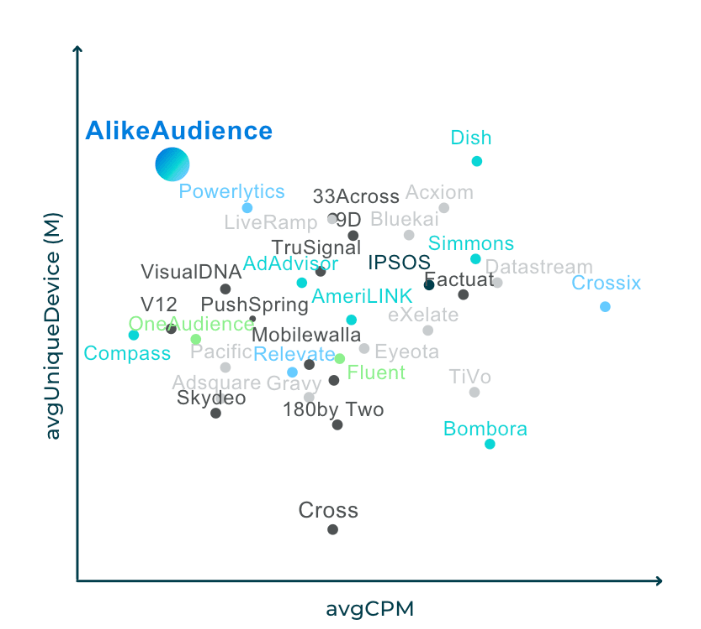
To build the most accurate lookalike models, audience data is imperative.
With programmatic media buying especially, where everything is driven by machine learning and artificial intelligence, you must leverage data strategically at every step of the way: from choosing target audiences to measuring the effectiveness of your campaign.
However, the current data market is highly saturated and competitive, with every data vendor claiming they can fulfill your needs. To choose the right partner in data, you’ll need to ask the right questions and dig deeper into the data collection process.
Specifically, there are two main things to consider:
1. Proximity to data sources
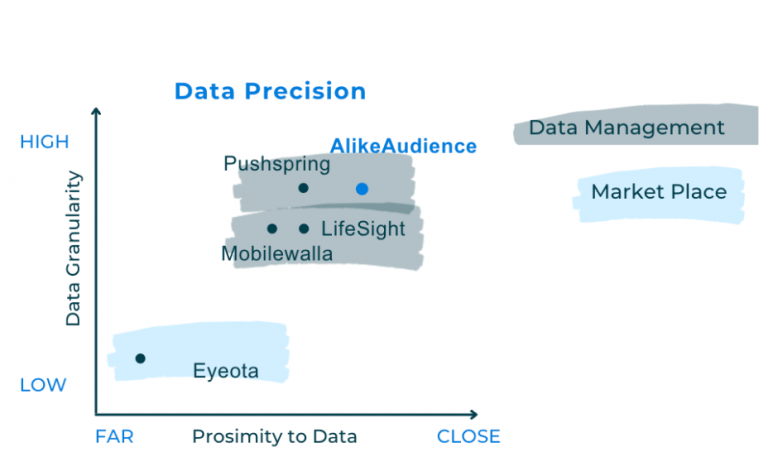
Data vendors can either aggregate their audience data from multiple vendors (data aggregators/recyclers) or source it directly from trusted partners. In the case of data aggregators, how each segment is defined comes from multiple sources.
For example, data provider A may define soccer lovers as someone who has bought soccer equipment and watches soccer on their personal device. Meanwhile, data provider B places a user in this segment just because the user accidentally clicked on an article related to soccer. When multiple providers each have their own collection method, it leads to irrelevant audiences.
As a top-10 data management provider in the APAC, AlikeAudience addresses this prevalent problem in the third-party marketplace by sourcing our IDs directly from trusted partners and global brands.
We provide clear and consistent methodology across all of our segments with over 7000 privacy-compliant audience segments at scale across 13 countries, namely US, Hong Kong, Australia, Japan, and Indonesia.
Not only can AlikeAudience provide high-scale segments, we can also generate the most refreshed and relevant audiences with the added flexibility for you to create custom segments with different lookback windows.
More importantly, as marketers, you’ll have full transparency into the way we build our segments and get to decide whether it makes sense to you and your client, before we start working together.
2. The future of data is opted-in and consumer consented
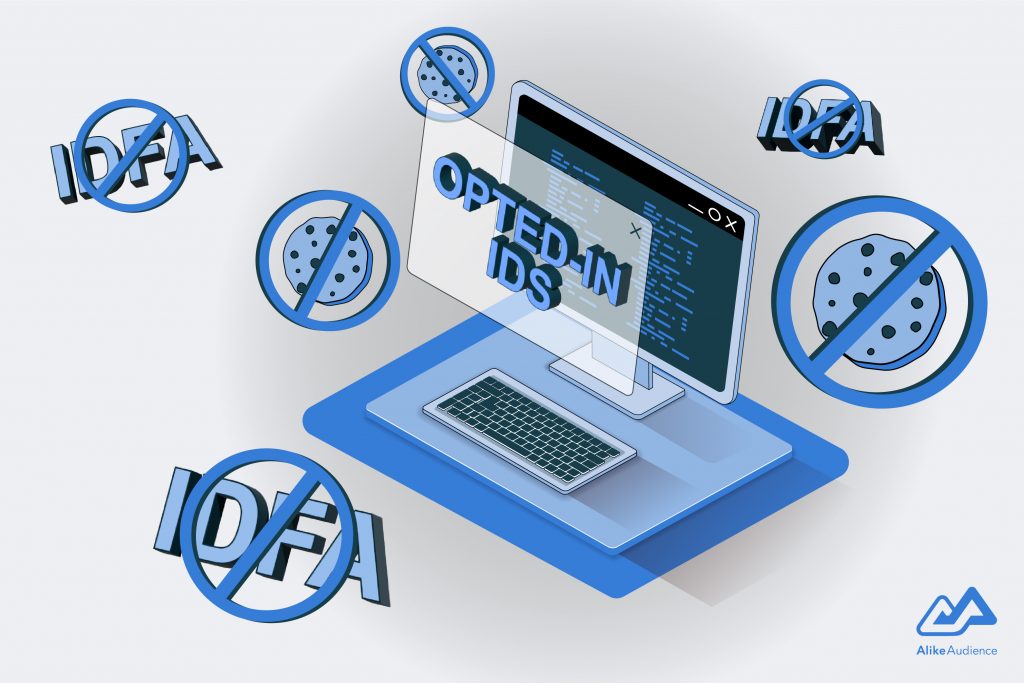
With third party cookies and IDFAs fading out, marketers are in greater need than ever for vendors that provide consumer-consented data. If customers don’t want a value exchange from the beginning, it’s unlikely that they’ll engage with your brand and buy your products down the road.
On the flip side, walled gardens like Google Ads and Facebook Ads which have high customer registration rates, but don’t necessarily carry a high-opt in rate. Just consider the fact that Facebook ranks last in digital trust among consumers.
With the drop in targeted reach and third party cookies diminishing, many marketers are moving towards alternative identity solutions, like universal IDs (UIDs). UIDs aim to replace third party cookies and help marketers bypass the cookie syncing process across the open internet.
Prominent ad-tech consortiums like The TradeDesk and LiveRamp are now providing a shared UID to identify users across the supply chain.
AlikeAudience is a pioneer adopter of TradeDesk’s UID2.0, Yahoo ConnectID, and LiveRamp’s RampID to meet the privacy-first market demand. We’ve only been working with consented UIDs and hashed emails ever since the IDFA and third party cookies announcements.
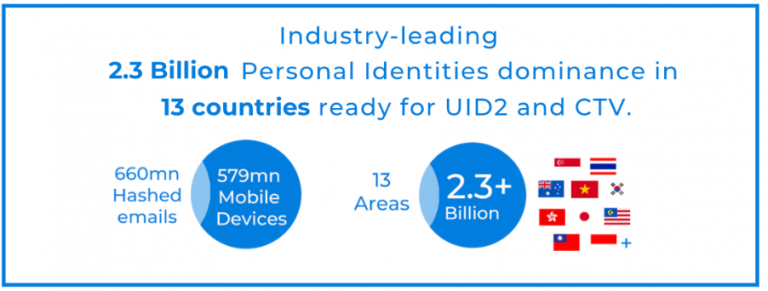
Our audience segments are sourced exclusively from 2.3billion opted-in mobile IDs and consented data that is fully compliant with GDPR and CCPA regulations.
We obtain raw data from global brands, top-tier credit card companies, and mobile signals, “cleanse” them, then apply lookalike modeling to ensure all personal identifying information is removed.
This is how our data collection method works:
- Our app publisher and KOCHAVA partners feed us attributes like app ownership and usage. In many cases, especially on social dating apps, they require the user to declare their age and gender.
- We aggregate this self-declared demographic information and test it against Nielsen Digital Ad Ratings (DAR) to form our OTP validated segments.
- Then, we work with partners like MasterCard and credit bureaus like Experian and TransUnion to understand more about these consumers based on their past purchases, socioeconomic statuses and income levels. This is used to form a lot of our other segments such as demographic and purchase intent segments.
Strategy #3 Map your omnichannel advertising strategy and define goals.
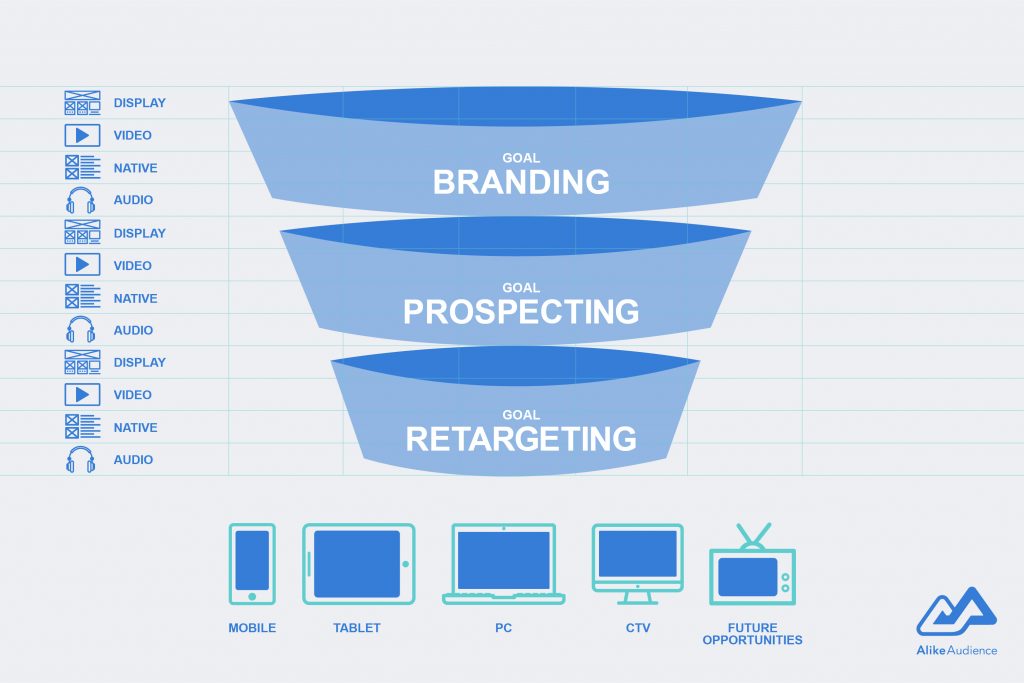
Once you have the audience data that you need, the next step is to map out your omnichannel strategy and set your programmatic goals.
Omnichannel marketing is a highly consumer-centric approach that looks at how consumers move down a sales funnel and interact with different display channels and mediums. This approach allows marketers to meet their target audiences where they are and deliver consistent messaging and unified experiences on each channel.
An omnichannel ecosystem consists of several components that you should map out to create a cohesive programmatic plan. Let’s look at each of them.
1. Choose your market for programmatic platforms: open vs private
The current programmatic ecosystem is divided into two main marketplaces: private and public. In the public or open marketplace, every advertiser engages in an auction and bids for automatic ad placements. There are two types of auctions in the open space: first-price and second-price.
Marketers who engage in first-price auctions pay exactly the price they’ve bid on an advertising impression. But in a second-price auction, they pay $0.01 more than the second highest bid. If the second bid is lower than the highest bid in the market, marketers can save on their ad spend, known as the reduction. Most advertisers starting out with programmatic campaigns might choose to go into the open marketplace since it’s more cost-effective.
In the private marketplace, marketers use their bargaining power to negotiate an exclusive look into ad impressions or form private contracts with publishers. They pay flat rates that have been previously agreed upon to buy the ad impressions before they reach the open marketplace. A private marketplace is suitable for advertisers with big programmatic budgets who are willing to pay premium CPMs for premium inventory.
2. Set your objectives across the sales funnel
A sales funnel in an omnichannel can be divided into three stages of a customer journey. For each stage, you need to set a different objective that dictates what you should do with your ad dollars. Typically, the funnel is wider at the top as there is usually a wider pool of customers in the awareness stage and narrows down as more customers move along the funnel.
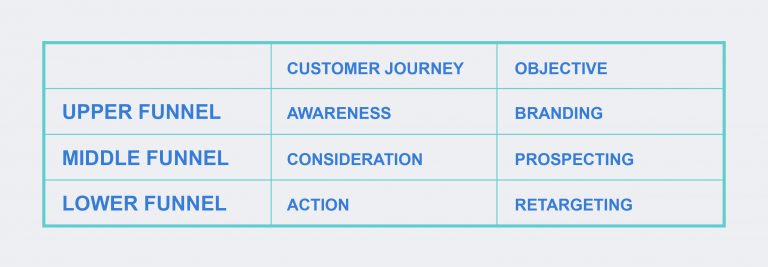
At the top of the funnel, your ad spend will go towards increasing brand awareness and finding new audiences that will be interested in your advertised product.
Moving down to the middle, the main goal of your ad spend is to get your target audiences to engage with your brand as they’re already aware of what you offer. You can often find these customers by tracking visitors to your website or clicks on your ads.
At the lower end of your funnel are customers that have already engaged with our brand and your ad spend will be directed towards encouraging them to take the desired action.
3. Choose your advertisement type
Once you’ve determined your initial objectives, think about what kind of advertisement type would resonate most with your target audiences. Typically, your ads can be:
- • Videos
- • Audio
- • Display banners
- • Rich media
- • Native editorial content
When making the format decision, consider the audience data that you gathered in the beginning of your campaign, your budget, and ad sizes.
Create flexible messages that can be regenerated into different formats and channels. Look into the data insights of your previous ads and analyze which format worked best in reaching your goals for specific audiences.
4. Determine the channel to run your ads
Once you’ve decided on an ad type, you can run it on multiple devices, such as mobile phones, laptops, or connected TVs, depending on what your target audiences consume the most at each stage of the funnel. For example, if your target audience is an 18-year old who frequently streams YouTube videos on his phone, you’ll want to run your ad on mobile phones.
Strategy #4 Adjust and grow your omnichannel programmatic plan.
In an omnichannel programmatic campaign, you can target countless combinations of devices, channels, and audiences according to your marketing goals. The TradeDesk has compiled an Omnichannel Map Template to help you plan these combinations effectively:
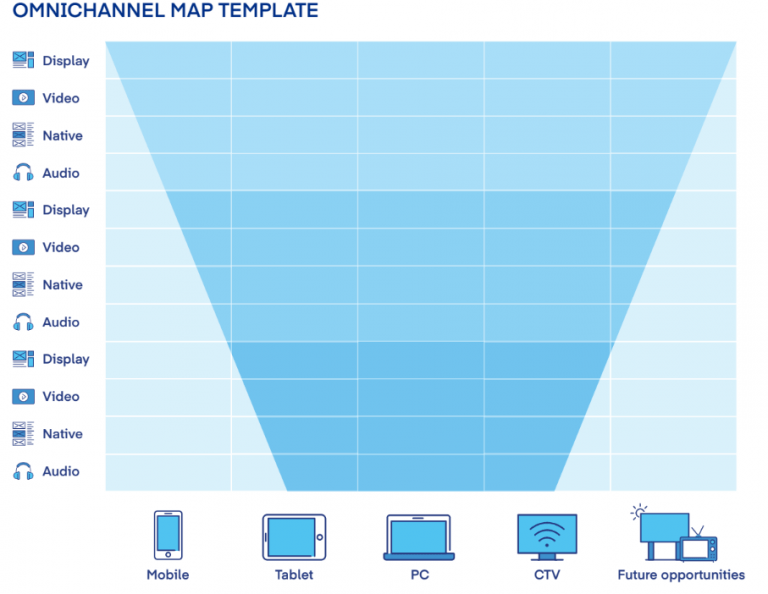
Each block of the funnel represents a combination of ad type and device. For example, you can run a display ad on computers for audiences in the upper funnel, or run a video ad on CTVs for those in the middle funnel. You can either bid on the ads to be shown on any device in the open marketplace or form a contract with a private marketplace.
It can be more cost-effective to focus your digital marketing efforts on one block of the funnel and grow from there. If you want to switch from targeting customers at the top of the funnel to those at the bottom, you’ll need to start over completely from scratch: picking a new type of channel and creating a new type of advertisement. And when your market changes, you’ll need to target new inventory resulting in different CPMs and a reshuffle in your ad budget.
Rather than going into new areas of the omnichannel landscape, go for careful and lengthy planning. As you grow your campaign, work with reputable programmatic marketplaces, who’ll look into data insights to recommend the next opportunities for you.
Strategy #5 Rely on data science for measurement
Traditionally, measurement was largely based on circulation numbers of a magazine or viewership of a TV program. While these numbers can play into choosing where to advertise, they shouldn’t be a part of the measurement metrics for your ad campaigns. For the longest time, there wasn’t abundant and accurate data to discover if your ads were successful in driving purchases for your products.
For programmatic advertising in the open marketplace, data science is the key to measure the effect of every ad on every customer. Examine a number of touchpoints, such as visits to your website, clicks on your ads, direct messages to your social media inbox, etc, to determine how many of your customers are likely to engage with your brand as a direct result of your ads.
These insights can fuel your decisions on what kind of customers you should target, how to pique their interest, and nudge them along the customer journey towards purchase and loyalty.
You can track these insights through an automated digital marketing reporting dashboard which will compile and visualize data from various ad campaigns and channels. Analyze which campaigns are performing well, and why, and reallocate your ad budget to successful campaigns.
Conclusion
In this article, we gave you a detailed breakdown of five strategies to plan your programmatic campaign, from building lookalike models to measuring ad performance. As with any campaign, understanding and connecting with your ideal customers is endemic to drive the most lucrative returns on your ad dollars.
AlikeAudience has your back for your audience data needs. Whether it’s custom or ready-made, we offer privacy-compliant, accurate, and device-agnostic audience segments across multiple industries – CPG, e-commerce, financial and insurance, travel and hospitality, entertainment, CTV, and more.
Through our invaluable partnerships with industry giants like The Trade Desk, LiveRamp, and PubMatic, we deliver next-generation, future-proof audience solutions to drive the best results on your programmatic campaigns.
Contact our data strategist today or sign up for our email for more insights.

